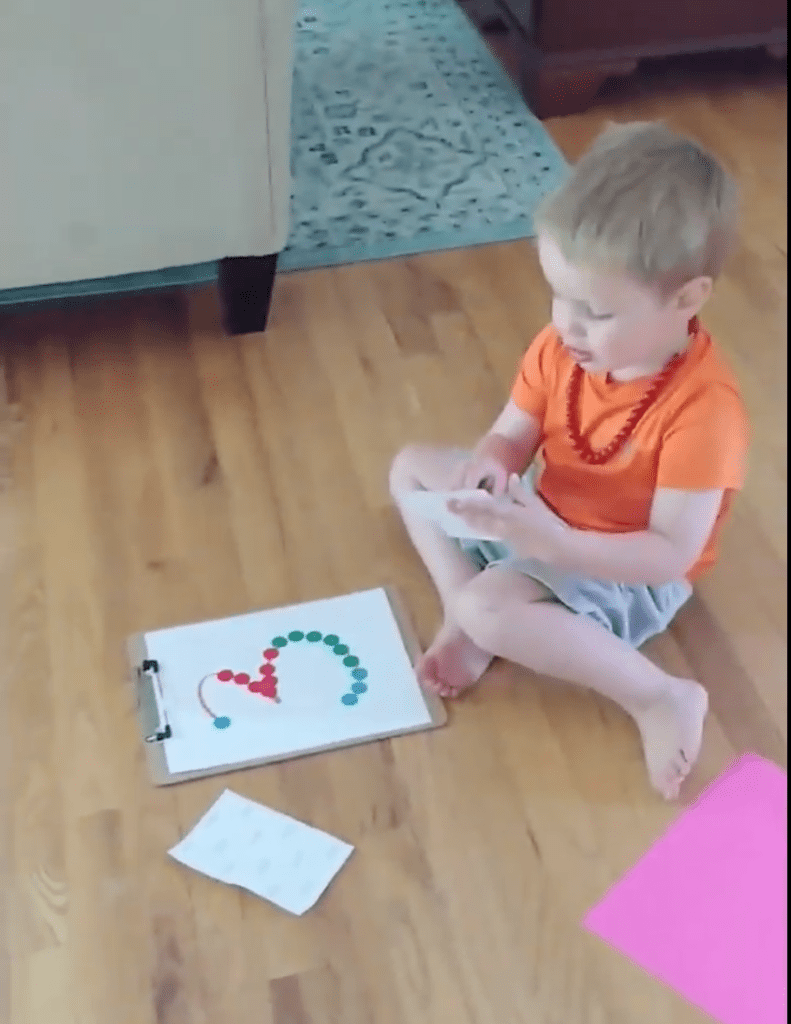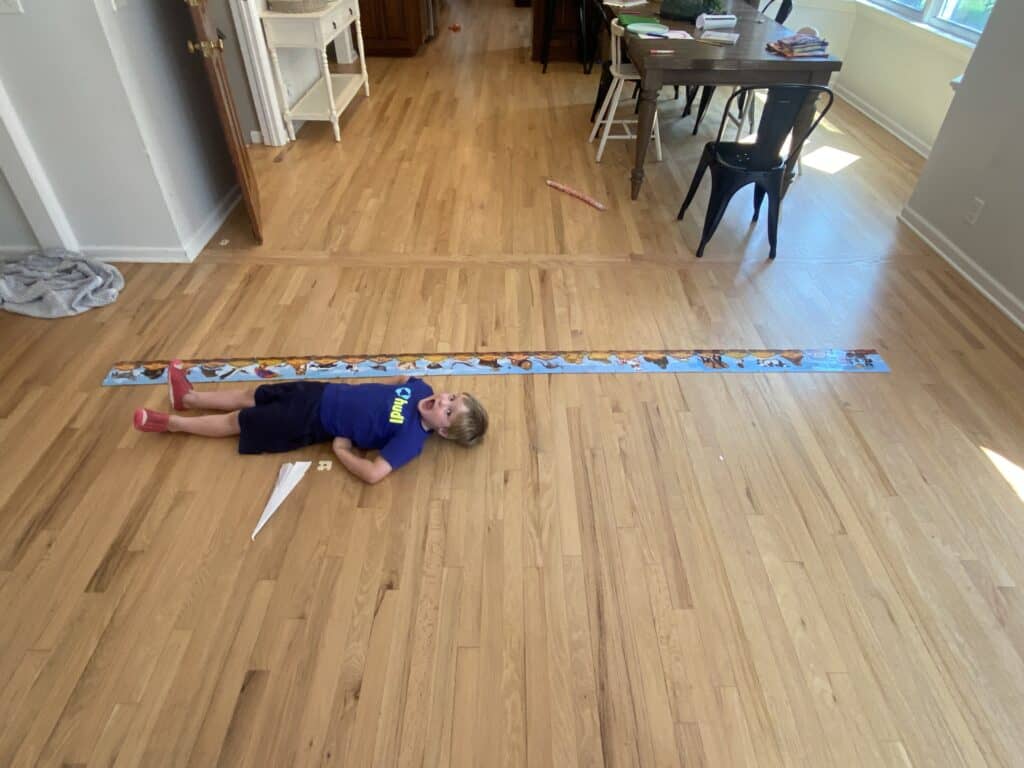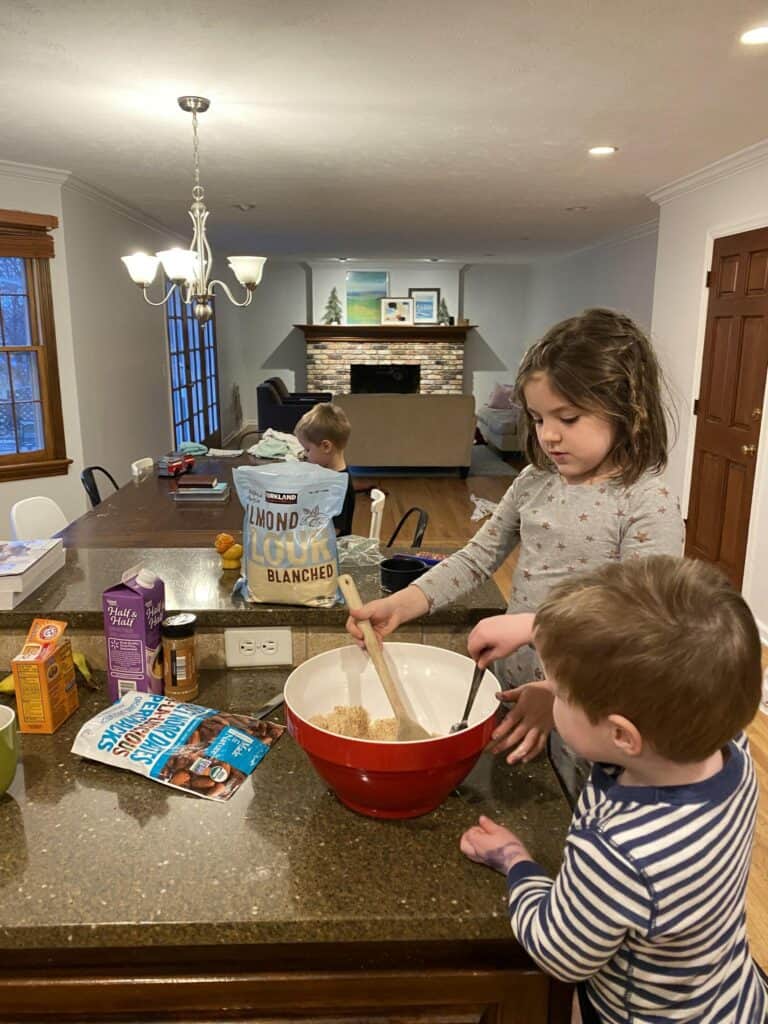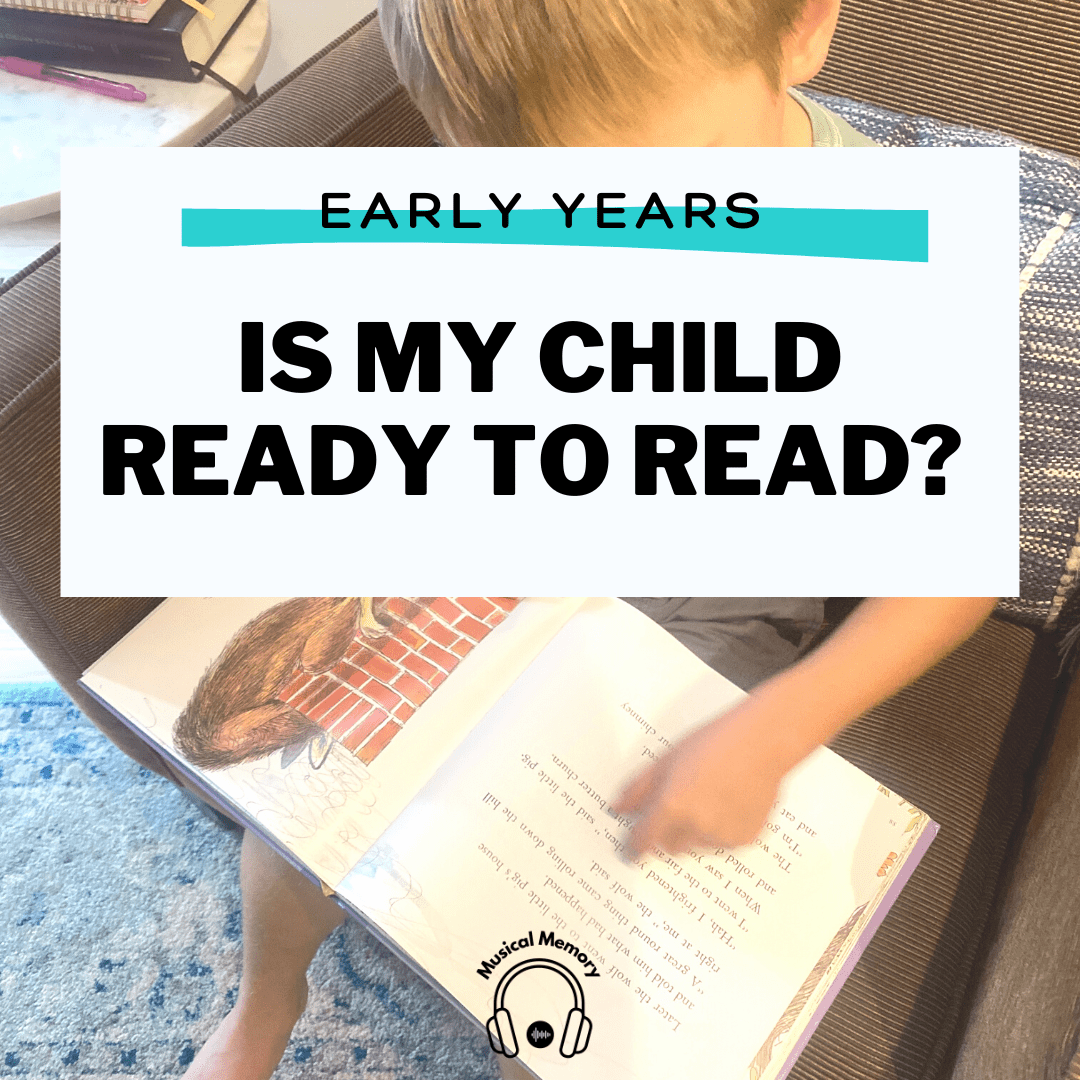You can teach your child to read at home.
You don’t need fancy curriculum or expensive toys. You don’t need a professional education either!
Once you understand 3 simple keys to reading readiness, you can teach your child to read at home. The 3 keys are: print awareness, learning phonogram sounds, and learning auditory blending. They’re all explained below!
In this post, I’ll explain:
- What to do with toddlers and young preschoolers to get them ready to read
- How to evaluate if your child is ready to read
- Some simple pre-reading games & activities that can fit into your everyday life for pre-readers of any age.
Use the tools and ideas in this guide as a starting point for experiencing the magic of watching your child fall in love with reading.
First, let’s talk about setting up your toddlers & preschoolers for reading success.
Is ‘Tot School’ Necessary?
Nope!! In fact, toddlers are ALWAYS learning. They are incredibly observant about the world about them, and they learn through observation and copying. If your child is younger than 3, spend lots of time reading, singing and engaging with your child.
- Talk a lot face to face (phone down)
- Read a lot of books out loud
- Ask questions & answer theirs
- Minimize screen time
- Play outside
- Let them be little
You have permission to ignore all the things marketed at you under the banner of “educational” activities for toddlers. In the way of ‘education,’ toddlers need:
- Simple, open-ended toys (think: blocks, Duplos, stued animals, sticks, dolls, balls)
- TONS unstructured play time (alone and with others)
- Conversation with adults
That’s it. My favorite book recommendation for parents of toddlers is Making the Terrible Twos Terrific (Rosemond).
How do I know if my child is ready to read?
At some point around age 3-5, your child will likely begin showing interest in words, letters, and numbers. For example, they might notice your t-shirt and ask, “What does that say?” or ask you to show them how to write their name. They’ll point out cool looking letters on signs and in books or puzzles.
Reading may be a ways down the road, but those are the first signs that your child has realized that letters and/or words mean something. This is the 1st key ‘light bulb’ moment!
You do not need to rush out and get fancy letter activities or workbooks. Rather, you can begin intentionally working certain pre-reading skills and simple practices into your day-to day life.
Pre-Reading Activities for 3-4 Year Olds
1. FIRST LETTER OF FIRST NAME
Write the first letter of their name on a big sheet of paper and cover the letter in stickers. If they want to keep going (or pick it up another day again) do it with each letter in their name until you have all the letters in their name and post it on their wall. Say it a lot. “L for Luke… LLLLLLUKE!”
Recognizing initial letter sounds is one of many important building blocks for early literacy. Starting with recognizing the first sound of family members’ names is a great way to build pre-reading language skills. (Mom starts with mmmm. Dad starts with /d/.)

2. GET A GOOD ALPHABET PUZZLE OR TWO.
My preschoolers loved this 10 foot long train one. This puzzle has been one of those everyday activities every child in our house has obsessed with for a couple months around age 4.5. It’s great for working on letter recognition at a young age.

3. SING SONGS
Find some basic preschool songs on Spotify for when you’re driving around or playing at home. My preschool spotify playlist is how all our kids have learned days of the week, months of the year, the alphabet song, plus tons of other silly playtime songs too.
I also made up a song or chant for how to spell each child’s name, which kids love!
I also wrote an entire singing-based memorization program geared towards 4-11 year olds. My younger kids who heard their older siblings singing this for years ahead of them learned it so well. I’m a huge fan of playing our fun learning songs for kids even at 3 years old. Just grab the Year 1 program & start playing the weekly playlist in the car, at lunch, or while the kids play. After 8-12 months, switch to the year 2 program, then year 3. When the child is 5 or 6 go back to year 1 and try to learn the actual words to the songs together as part of 1st-2nd grade work.
4. MAKE A-B-A-B-A-B PATTERNS…
Use toys or nature-findings: pinecone, pebble, pinecone, pebble. Stack Duplos red, blue, red, blue. Play with cars & figures… car, person, car, person. Or food… apple, orange, apple, orange.
You get the idea. 😉
Using around the house objects to create patterns provides such strong visuals… you’ll never need a workbook for pattern work.
5. KITCHEN HELPERS
Say “yes” to them helping in the kitchen as much as possible – teach your 3 year old to crack an egg, carefully level a cup of our, stir without spilling everywhere, etc.
Every child of ours has loved to help in the kitchen. It can be a bit chaotic, so I try to not let them help when I’m rushing. But working in the kitchen is one of the best ways to strengthen shaky fine motor skills, personal responsibility, physical spatial awareness. Plus it’s fun!

6. COUNT ONE TO ONE
Counting one to one just means you teach the child to correlate one object to one number. The best time to demonstrate this is after your 3-4 year old starts rattling off, “1-2-3-4-5-9-10!!” by rote with no real understanding as to what it means.
Whenever the child goes to mimic counting real objects, you pause them and say, let me show you. Then point or slide each object very carefully one at a time while saying… 1, 2, 3.
Let them do it. If they just say, “1-2-3” quickly with no correlation to the object, help them point with their fingers and say, “Let’s count 1 at a time.” or “Careful counting is 1 [pause] 2 [pause] 3 [pause.]” Always touching or sliding the object exactly when you say the number.
Don’t get a workbook and start circling objects… just count real things whenever it comes up.
You can count while you collect sticks or dandelions on the way to the park. Count dishes when setting the table. Count boxes when at the grocery store. Hands on & real life is the name of the game for preschoolers.
7. LAST BUT NOT LEAST, READ A LOT TOGETHER!
Whether you purchase books or use the library, keep a huge collection of board books and picture books in your home. Make them easily accessible to your little ones. The best position for books in is forward facing or in baskets that aren’t too full.
Reading aloud is by far the most important activity, educationally, that you can do with your child. How much the primary adults in the child’s life read to them is a major indicator of academic success in the future. Read out loud to your children from an early age, even if they’re just playing nearby. It’ll set the stage for enjoying picture books together for the long haul.
If you want some further inspiration or proof that reading together is “enough,” check out Jim Trellis’ Read Aloud Handbook. I highly recommend it! He has studied the benefits of reading aloud to children (from tiny babies to teens) for years. This was one of the first books in my “parent education” journey as a homeschool mom.
Plus he has a GREAT booklist in there with books you won’t get tired of reading “again, again, again.”
3 Literacy Keys for the Early Child Learning to Read
So, what are the 3 most important things for reading readiness?
#1 – General Print Awareness
Your 2 year old probably hasn’t realized that the random symbols all over the pages of books have some sort of meaning. He may mimic you by pointing to words & babbling. He’ll turn pages and may even have parts of a favorite book memorized! But toddlers don’t really understand that the letters have meaning.
However, if you have frequently read to your toddler, by age 3 or 4 or 5, he may become aware of the letters. He’ll realize that those things on the page mean something and this is the indicator your child is developing print awareness, one of the first few early literacy skills.
If you haven’t been reading aloud to your child, it’s never too late to start! Search “best children’s books for ___ year olds,” and go check out the top 10 from your library. If you’re trying to instill a new habit with a very young child, read 1 or 2 short books at the same time in the same spot every day. (i.e. before bed, during lunch, right when he wakes up while he has a drink) And read the Read Aloud Handbook I mentioned on the previous page!
Even if your child wanders away or plays or throws the books around, just keep reading. Eventually, he’ll start showing interest.
The main way to instill a general awareness of reading is to read aloud a lot & occasionally point things out. Point the words while you read, left to right. Stop reading and say, “turn the page,” to indicate that you ran out of words and needed new words to read. If your child recognizes some letters, point them out in the book. “Look! An “A” in the book! Just like your name starts with A.”
#2 – Phonograms
Phonograms!? What in the world are those? They are the basic sounds of a language. The words in English are made up of 75 dierent phonograms (single or multi-letter sounds).
B says /b/ as in bat.
S has two sounds – /s/ (snake) & /z/ (has)
A has 3 sounds – /a/ (apple) /A/ (hate) & /ah/ (father)
The first step to reading is learning a handful of phonograms, or letter sounds. It may sound old fashioned or confusing or daunting, but I promise you – it’s not hard. You’ll probably be AMAZED at how quickly your child picks up the individual sounds. When my oldest learned them at 6, her 4 year old sister joined right along. Their younger brother was jealous he didn’t have “color letter cards” (colored ash cards with letter sounds on them), so I made him some and he started learning them too… at 3 years of age.
Side note: some people will say a child’s brain isn’t ready to learn letter sounds at age 4, but I’ve found it really depends on the child and his individual brain development. Pay attention to your child and teach them where they’re at.
In our home, those younger kids who learned their phonograms alongside their first grade sister were very early, fluent, successful readers. It was amazing to see. My 4th child didn’t seem as interested in letter knowledge until he was closer to 4.5 or 5. But once he was interested, he took off. Even starting at age 6-7 would be developmentally fine!! There’s no race to learn to read.
Kids love them! They’re fast, fun and easy.
#3 – Blending Phonograms into Words
Many reading methods assume kids can decode the individual phonogram sounds that make up a word and automatically hear them blended together. Wrong! While some kids do pick this up naturally, many other children get stuck in their reading progress because they don’t explicitly learn how to blend multiple sounds together.
The key to getting over the hump of blending is to practice with a super simple auditory game called Say it Slow, Say it Fast – explained more in depth here.
This game will singlehandedly introduce the most important elements of phonological awareness – meaning an awareness of the sounds of words and letters. You can start this game as early as age 3-4 a while before your child is ready to read.
It can be simple & fun to teach & practice “blending.”
For example, the word cat is made up of 3 sounds-/c/ /a/ /t/.
But it takes a lot of practice to see the word cat, recall and say each sound individually, and realize that they form the word cat.
REVERSE BLENDING GAME – The reverse of blending letters together is breaking them apart to hear the smaller sounds inside a big word. So you would say, “What sounds do you hear in the word cat?” and have the child say, “/c/ /a/ /t/.” This is called segmenting. It’s another one of those early literacy activities that is easy to practice at home.
Typically, children have an easier time blending than segmenting, so just let them develop at their own pace. Don’t worry if this is harder for them at first.
Bonus Tip – Start a Library Tradition
One way (not the only way) to instill a love of reading in your kids is to be frequent visitors of public libraries. Maybe you already are? Great!
If not, here are some ideas for getting started at your local public library:
1. Get a kids’ card – sometimes the library service has special return policies with extra grace periods for children’s books.
2. Spend 30 minutes creating an online account and guring out the website and/or app. Learn how to put books on hold! Even if you can’t go spend a whole morning or afternoon at the library, you can easily snag some great new books every week in less than 5 minutes once you’re comfortable using your library’s digital hold system.
3. Grab a good book list and start working your way through it – a few places to start are: Time magazine 100 best children’s books, The Good & The Beautiful Booklist, Read Aloud Handbook, Read Aloud Revival, & Give Your Child the World.
4. Go to story time, or another library program that is offered. You’ll probably get to know some public library staff and other families.
Start some library traditions too. (Anything you do more than once and call “a tradition” sticks with kids! Winning!) Here are some ideas:
- Have a designated bag for books & bring the same special snacks to the library every time.
- Come home & eat the same lunch every week while mom reads aloud 3 new library books.
- Lay out all the new books on the oor & have the kids take turns choosing to create a pile. Then send them off to cozy reading spots with a snack & enjoy some quiet time! (Post library time is the quietest my house gets all week… haha)
Learning to Read at Home
Teaching our kids to read, while sometimes painstakingly slow, has also been such a fun gift and surprise. You are your child’s first teacher and it’s such a gift to your kid to allow them to learn to read at their own pace, snuggled up next to Mom or Dad on the couch.
You heard their first cry and first word, you watch them take their first steps…. you might as well be the one to teach them that A says /a/ as in apple & watch them learn to read.
Plus who knows your kid better than you? Often, I find that a motivated parent is the best teacher for a child because they’re the one who cares the most.
Other Posts You Might Like:
- READ THIS NEXT – Everything you ever wanted to know about phonograms and how to teach them (or more than you ever wanted to know… haha)
- THEN READ THIS – How to teach reading & spelling at home (4-7 year olds)




